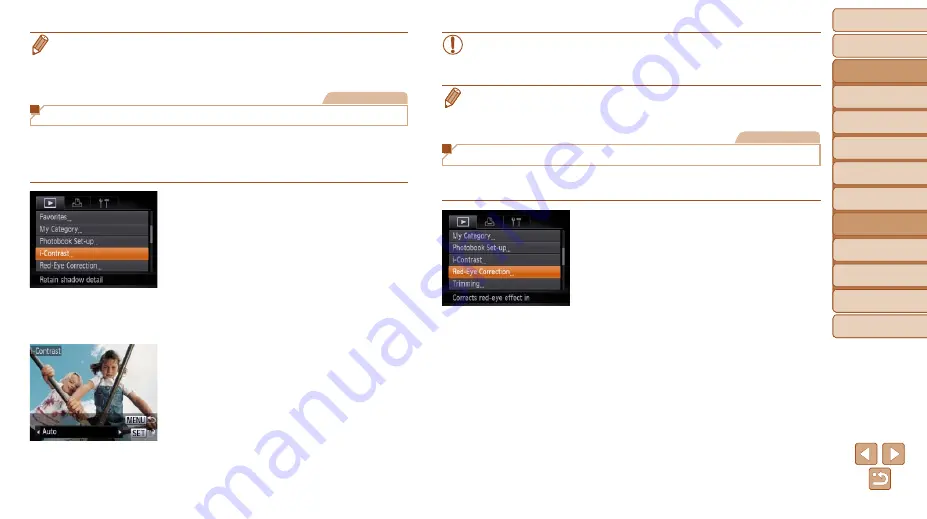
Before Use
Basic Guide
Advanced Guide
Camera Basics
Using GPS
Functions
Auto Mode
Other Shooting
Modes
P Mode
Playback Mode
Setting Menu
Accessories
Appendix
Index
100
Before Use
Basic Guide
Advanced Guide
Camera Basics
Using GPS
Functions
Auto Mode
Other Shooting
Modes
P Mode
Playback Mode
Setting Menu
Accessories
Appendix
Index
•
The color of images edited using this function may vary slightly from the color
of images shot using My Colors (
Still Images
Correcting Image Brightness (i-Contrast)
Excessively dark image areas (such as faces or backgrounds) can be detected
and automatically adjusted to the optimal brightness. Insufficient overall image
contrast is also automatically corrected, to make subjects stand out better.
Choose from four correction levels, and then save the image as a separate file.
1
Choose [i-Contrast].
z
z
Press the <
n
> button, and then choose
[i-Contrast] on the [
1
).
2
Choose an image.
z
z
Press the <
q
><
r
> buttons to choose an
image, and then press the <
m
> button.
3
Choose an option.
z
z
Press the <
q
><
r
> buttons to choose an
option, and then press the <
m
> button.
4
Save as a new image and review.
z
z
Follow steps 4 – 5 in “Resizing Images”
(
).
•
For some images, correction may be inaccurate or may cause
images to appear grainy.
•
Images may look grainy after repeated editing using this function.
•
If [Auto] does not produce the expected results, try correcting images using
[Low], [Medium], or [High].
Still Images
Correcting Red-Eye
Automatically corrects images affected by red-eye. You can save the
corrected image as a separate file.
1
Choose [Red-Eye Correction].
z
z
Press the <
n
> button, and then
choose [Red-Eye Correction] on the [
1
]
tab (
).
2
Choose an image.
z
z
Press the <
q
><
r
> buttons to choose an
image.
3
Correct the image.
z
z
Press the <
m
> button.
z
z
Red-eye detected by the camera is now
corrected, and frames are displayed
around corrected image areas.
z
z
Enlarge or reduce images as needed.
Follow the steps in “Magnifying Images”
(






























